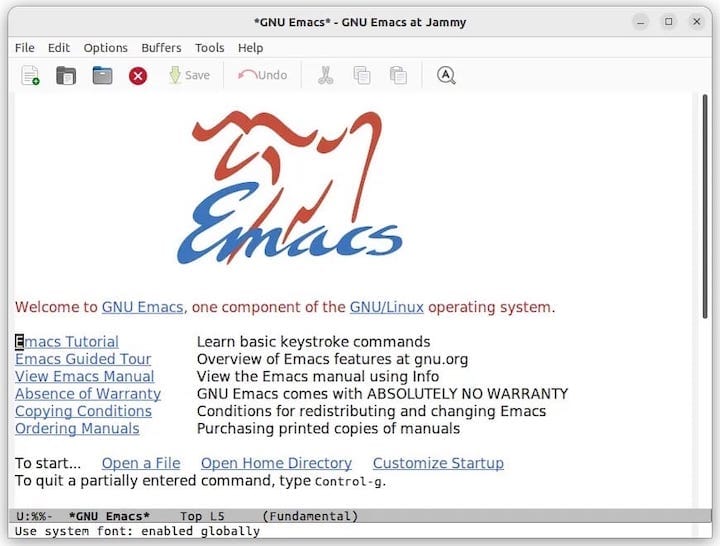How To Install Emacs on Debian 13

Emacs stands as one of the most powerful and versatile text editors available for Linux systems. This comprehensive guide covers how to install Emacs on Debian 13 using multiple installation methods, ensuring you can choose the approach that best suits your specific needs and technical requirements.
Whether you’re a system administrator, developer, or power user, understanding the various installation options for Emacs on Debian 13 will help you maximize your productivity. From simple package manager installations to building from source code, this tutorial provides detailed step-by-step instructions for each method.
Prerequisites and System Requirements
Before beginning the Emacs installation process on Debian 13, ensure your system meets the basic requirements. Your Debian 13 system should have at least 512MB of RAM and 200MB of free disk space for a standard installation. Administrative privileges through sudo access are essential for most installation methods.
Check your current Debian version by running lsb_release -a in the terminal. Verify available disk space using df -h to ensure adequate storage for the installation. A stable internet connection is required for downloading packages and dependencies.
Update your system’s package lists before proceeding with any installation method. This ensures you have access to the latest package versions and security updates. Basic familiarity with the command line interface will significantly enhance your installation experience.
Method 1: Installing Emacs Using APT Package Manager
Updating Package Repository
The APT package manager represents the most straightforward approach for installing Emacs on Debian 13. Begin by updating your package repository to ensure access to the latest available packages.
sudo apt updateThis command refreshes the local package database with the most recent package information from Debian repositories. The update process typically completes within a few minutes, depending on your internet connection speed.
If you encounter repository errors during the update process, verify your /etc/apt/sources.list file contains valid Debian 13 repository entries. Network connectivity issues may also prevent successful updates.
Installing Emacs via APT
Execute the primary installation command to install Emacs through the APT package manager:
sudo apt install emacsThe APT system automatically resolves and installs all necessary dependencies. This includes essential libraries, fonts, and supporting packages required for optimal Emacs functionality.
During installation, the system downloads approximately 50-100MB of packages, depending on currently installed dependencies. The process typically completes within 5-10 minutes on most systems.
Verify successful installation by running emacs --version in the terminal. This command displays the installed Emacs version and confirms proper installation.
Alternative APT Installation Options
Debian 13 repositories offer several Emacs variants tailored for different use cases. The emacs-nox package provides a terminal-only version without X11 dependencies, ideal for server environments or minimal installations.
sudo apt install emacs-noxFor users requiring specific GUI frameworks, emacs-gtk offers enhanced integration with GTK-based desktop environments. Use the --no-install-recommends flag to minimize additional package installations:
sudo apt install --no-install-recommends emacs-gtkConsider installing additional Emacs packages such as emacs-common-non-dfsg for comprehensive documentation and elpa-* packages for extended functionality.
Method 2: Installing via Snap Package Manager
Understanding Snap Packages
Snap packages provide a universal installation method that works across different Linux distributions. Snap-packaged applications run in isolated environments, offering enhanced security and simplified dependency management.
The Snap installation method delivers the latest Emacs versions more quickly than traditional repositories. Automatic updates ensure you always have access to recent features and security patches.
Snap packages consume slightly more disk space due to their self-contained nature. However, this approach eliminates potential conflicts with system libraries and dependencies.
Installing Emacs via Snap
First, ensure the snapd daemon is installed and running on your Debian 13 system:
sudo apt install snapd
sudo systemctl enable --now snapdInstall Emacs using the Snap package manager:
sudo snap install emacs --classicThe --classic flag grants the application access to system resources beyond the typical Snap sandbox. This access is necessary for Emacs to function properly with system files and external tools.
Managing Snap-installed Emacs
Snap packages update automatically by default. Manual updates can be triggered using sudo snap refresh emacs. Monitor installed Snap packages with snap list.
Remove Snap-installed Emacs using sudo snap remove emacs. Configuration files typically remain in the user’s home directory after removal.
Snap installations create desktop entries automatically, integrating Emacs with your desktop environment’s application menu and file associations.
Method 3: Installing via Flatpak
Setting up Flatpak on Debian 13
Flatpak provides another containerized application distribution method. Install Flatpak support on your Debian 13 system:
sudo apt install flatpakAdd the Flathub repository, which hosts thousands of Flatpak applications:
flatpak remote-add --if-not-exists flathub https://flathub.org/repo/flathub.flatpakrepoRestart your system or log out and back in to ensure proper Flatpak integration with your desktop environment.
Installing Emacs via Flatpak
Search for available Emacs packages in the Flathub repository:
flatpak search emacsInstall Emacs using Flatpak:
flatpak install flathub org.gnu.emacsFlatpak installations provide excellent isolation while maintaining good system integration. The installation includes all necessary runtime dependencies automatically.
Launch Flatpak-installed Emacs using flatpak run org.gnu.emacs or through your desktop environment’s application menu.

Method 4: Installing from Third-Party PPA Repository
Understanding PPA Repositories
Personal Package Archives (PPAs) offer access to newer software versions not available in official Debian repositories. Third-party PPAs may provide cutting-edge Emacs builds with experimental features.
Exercise caution when using third-party repositories, as they may introduce security risks or system instability. Always verify the reputation and trustworthiness of PPA maintainers before installation.
Adding Emacs PPA
Add a trusted third-party repository for newer Emacs versions:
sudo add-apt-repository ppa:kelleyk/emacs
sudo apt updateThis PPA maintains recent Emacs builds for Ubuntu and Debian systems. The repository typically offers multiple Emacs versions for compatibility with different system configurations.
Installing Latest Emacs Version
After adding the PPA, install the latest available Emacs version:
sudo apt install emacs29Specify particular version numbers when multiple versions are available. This approach allows you to install cutting-edge Emacs releases ahead of official repository inclusion.
Monitor PPA updates regularly to benefit from the latest features and security improvements. Remove PPA repositories if they become unmaintained or problematic.
Method 5: Compiling Emacs from Source Code
Installing Build Dependencies
Compiling Emacs from source provides maximum customization options and access to the absolute latest development versions. Install essential build tools and dependencies:
sudo apt install build-essential git autoconf texinfo libncurses-dev
sudo apt install libgtk-3-dev libgnutls28-dev libjpeg-dev libpng-dev
sudo apt install libtiff-dev libxml2-dev libxpm-devAdditional dependencies may be required based on desired Emacs features. Install librsvg2-dev for SVG support and libmagick++-dev for ImageMagick integration.
The complete dependency installation requires approximately 500MB of additional disk space. Compilation requires significantly more resources than package-based installations.
Downloading Emacs Source Code
Obtain the latest Emacs source code from the official GNU repository:
git clone https://git.savannah.gnu.org/git/emacs.git
cd emacsAlternatively, download specific release tarballs from the GNU FTP server:
wget https://ftp.gnu.org/gnu/emacs/emacs-30.2.tar.xz
tar -xf emacs-30.2.tar.xz
cd emacs-30.2Verify download integrity using provided checksums when downloading from FTP servers. Git clones include complete version history and development branches.
Compiling and Installing
Configure the build environment with your desired options:
./autogen.sh
./configure --with-native-compilation --with-json --with-imagemagickBegin the compilation process:
make -j$(nproc)The -j$(nproc) flag utilizes all available CPU cores for faster compilation. Expect compilation times between 15-60 minutes depending on system specifications.
Install the compiled Emacs binary:
sudo make installBy default, source installations place files in /usr/local/. Customize installation directories using ./configure --prefix=/opt/emacs for alternative locations.
Post-Installation Configuration
Verifying Installation
Confirm successful Emacs installation regardless of the chosen method:
emacs --version
which emacsThese commands display version information and binary location. Test basic functionality by launching Emacs and creating a simple text file.
Verify that all desired features work correctly, including syntax highlighting, package management, and external tool integration.
Initial Configuration Setup
Create the Emacs configuration directory in your home folder:
mkdir -p ~/.emacs.dModern Emacs versions respect XDG Base Directory specifications. Configuration files can also be placed in ~/.config/emacs/ for better organization.
Create an initial configuration file:
touch ~/.emacs.d/init.elAdd basic configuration settings to personalize your Emacs environment. Start with simple preferences like theme selection and basic key bindings.
Desktop Integration
Create desktop integration for GUI environments:
sudo update-desktop-database
sudo update-mime-database /usr/share/mimeConfigure Emacs as the default text editor:
sudo update-alternatives --install /usr/bin/editor editor /usr/bin/emacs 100Verify file associations work correctly by opening text files through your file manager. Emacs should appear in context menus and default application selections.
Common Emacs Packages and Extensions
Essential Packages for Beginners
Configure the built-in package manager for easy extension installation:
(require 'package)
(add-to-list 'package-archives '("melpa" . "https://melpa.org/packages/"))
(package-initialize)Install fundamental packages for enhanced productivity:
- use-package: Streamlined package configuration
- which-key: Interactive key binding help
- company: Text completion framework
- magit: Advanced Git integration
These packages significantly improve the default Emacs experience for new users.
Development-Focused Extensions
Programming-oriented users benefit from language-specific packages:
- lsp-mode: Language Server Protocol support
- projectile: Project management utilities
- flycheck: Syntax checking framework
- yasnippet: Template and snippet system
Configure these extensions according to your primary programming languages and development workflow requirements.
Troubleshooting Common Installation Issues
APT Installation Problems
Repository-related errors often stem from network connectivity issues or incorrect source configurations. Verify internet connectivity and DNS resolution:
ping -c 4 deb.debian.org
nslookup deb.debian.orgMissing package errors may indicate incomplete repository updates. Run sudo apt update again and verify repository accessibility.
Permission errors typically require sudo privileges for system-wide installations. Ensure your user account has appropriate administrative access.
Compilation Issues
Missing development dependencies cause most source compilation failures. Install the complete build-essential meta-package and all listed dependencies.
Configure script failures often indicate missing libraries or incompatible system configurations. Review configure output carefully for specific error messages and missing components.
Memory limitations can prevent successful compilation on resource-constrained systems. Consider using swap files or alternative installation methods for systems with limited RAM.
General Troubleshooting
Launch Emacs in debug mode to identify configuration issues:
emacs --debug-initReset Emacs configuration by temporarily renaming the .emacs.d directory. This helps isolate configuration-related problems from installation issues.
Community support through forums, mailing lists, and documentation provides excellent troubleshooting resources for complex problems.
Performance Optimization and Best Practices
System Performance Tuning
Optimize Emacs startup time by configuring lazy loading for packages and extensions. Use use-package with :defer keywords to delay package initialization until needed.
Configure appropriate memory settings for large file editing:
(setq gc-cons-threshold (* 100 1024 1024))
(setq read-process-output-max (* 1024 1024))Monitor Emacs resource usage using built-in profiling tools and system monitors to identify performance bottlenecks.
Security Best Practices
Regularly update Emacs installations regardless of the chosen installation method. Security patches address vulnerabilities and improve system stability.
Verify package sources and maintainer credibility before installing third-party extensions. Use official repositories whenever possible for maximum security.
Implement regular configuration backups using version control systems like Git. This practice protects against configuration corruption and enables easy restoration.
Uninstalling Emacs
Removing APT-installed Emacs
Remove Emacs packages installed through APT:
sudo apt remove emacs
sudo apt autoremovePurge configuration files completely:
sudo apt purge emacsRemoving Other Installation Types
Remove Snap packages:
sudo snap remove emacsUninstall Flatpak applications:
flatpak uninstall org.gnu.emacsFor source-compiled installations, remove files manually from the installation directory (typically /usr/local/).
Complete System Cleanup
Remove user configuration directories:
rm -rf ~/.emacs.d
rm -f ~/.emacsClear package manager caches and temporary files to reclaim disk space. Verify removal completeness by checking for remaining Emacs-related files.
Congratulations! You have successfully installed Emacs. Thanks for using this tutorial for installing GNU Emacs on your Debian 13 “Trixie” system. For additional help or useful information, we recommend you check the official Emacs website.